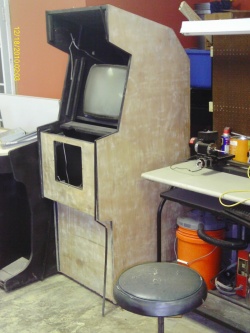Difference between revisions of "MAME Cabinet"
(Uno is not needed anymore) |
|||
| Line 34: | Line 34: | ||
=== Controls === | === Controls === | ||
| − | The Williams Defender cabinet shared the "base cabinet" with many other games like Joust and Sinistar. This fact makes it very easy to make multiple control decks. The control decks dimensions are 23 1/2 inches by 8 inches made of 3/4 | + | The Williams Defender cabinet shared the "base cabinet" with many other games like Joust and Sinistar. This fact makes it very easy to make multiple control decks. The control decks dimensions are 23 1/2 inches by 8 inches made of 3/4 particle board. |
We have a few leftover parts from the last MAME project, also a set ordered [http://www.ebay.com/itm/360450175737] form Ebay seller TwistedQuarter for $29.99 plus $10 shipping as a donation. | We have a few leftover parts from the last MAME project, also a set ordered [http://www.ebay.com/itm/360450175737] form Ebay seller TwistedQuarter for $29.99 plus $10 shipping as a donation. | ||
| − | + | Danny is currently running a custom firmware on an Arduino Uno and checking the results of that. | |
| − | |||
| − | |||
| − | |||
| − | |||
| − | |||
| − | |||
| − | |||
| − | |||
| − | |||
| − | |||
| − | |||
| − | |||
| − | |||
| − | |||
| − | |||
| − | |||
| − | |||
| − | |||
| − | |||
| − | |||
| − | |||
| − | |||
| − | |||
| − | |||
| − | |||
| − | |||
| − | |||
| − | |||
| − | |||
| − | |||
| − | |||
| − | |||
| − | |||
| − | |||
| − | |||
| − | |||
| − | |||
| − | |||
| − | |||
| − | |||
| − | |||
| − | |||
| − | |||
| − | |||
| − | |||
| − | |||
| − | |||
| − | |||
| − | |||
| − | |||
| − | |||
| − | |||
| − | |||
| − | |||
| − | |||
| − | |||
| − | |||
| − | |||
| − | |||
| − | |||
| − | |||
| − | |||
| − | |||
| − | |||
| − | |||
| − | |||
| − | |||
| − | |||
| − | |||
| − | |||
| − | |||
| − | |||
| − | |||
| − | |||
| − | |||
| − | |||
== Bill of Materials == | == Bill of Materials == | ||
*DC7600 | *DC7600 | ||
*Samsung 19 inch 930b LCD | *Samsung 19 inch 930b LCD | ||
| − | |||
*Defender Arcade Cabinet | *Defender Arcade Cabinet | ||
Revision as of 17:33, 14 February 2013
MAME, an acronym that stands for Multiple Arcade Machine Emulator, is an emulator designed to reproduce older arcade system hardware via software on a modern personal computer.
| MMMAME (Midsouth Makers MAME Cabinet) | |
|---|---|

Sanded cabinet and gutted | |
| Information | |
| Owner | Group |
| Lead | critter42 & MemphisArtGuy |
| Version | 2.0 |
| Status | In Progress |
| Started On | November 2012 |
| Cost | Free |
Design
Computer
- HP Compaq DC7600 Convertible Minitower PC 3.2 GHZ
- OS Ubuntu 12.04
- 2 HDD on SATA BUS - Roms Drive - OS Drive
- WIFI Adapter : ENUWI-G2 802.11 B/G
- 1Gb DDR2 - Would like to upgrade to 4Gb
- 19inch 3:4 LCD
Display
- Samsung 19inch 930B
Audio
- On Board
Software
Controls
The Williams Defender cabinet shared the "base cabinet" with many other games like Joust and Sinistar. This fact makes it very easy to make multiple control decks. The control decks dimensions are 23 1/2 inches by 8 inches made of 3/4 particle board.
We have a few leftover parts from the last MAME project, also a set ordered [1] form Ebay seller TwistedQuarter for $29.99 plus $10 shipping as a donation.
Danny is currently running a custom firmware on an Arduino Uno and checking the results of that.
Bill of Materials
- DC7600
- Samsung 19 inch 930b LCD
- Defender Arcade Cabinet
Contributors
- Ben
- Dan
- Danny
- Dru
- Mark
External Links
Cabrio
Virtual HID Keyboard
Arduino USB Sheild
Teensy HID Keyboard
Arduino Uno HID Keyboard